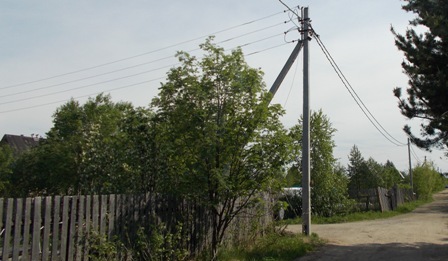Safety rules in the vicinity of a broken overhead power line conductor
 One of the most common emergency situations in electrical networks is a wire break in an overhead power line. As a rule, the power lines of these electrical networks, which operate in an isolated neutral mode, where a single-phase earth fault - that is, a wire falling to the ground, does not lead to the disconnection of the power supply to the line - pose a great danger.
One of the most common emergency situations in electrical networks is a wire break in an overhead power line. As a rule, the power lines of these electrical networks, which operate in an isolated neutral mode, where a single-phase earth fault - that is, a wire falling to the ground, does not lead to the disconnection of the power supply to the line - pose a great danger.
After a wire has fallen, such lines may be in service for some time until damage is found. These are high-voltage lines with a voltage of 6, 10, 35 kV.
In electrical networks with a voltage of 110 kV and above, any ground fault is an emergency mode and is usually disabled by high-speed protections. That is, when a conductor falls to the ground in these electrical networks, the line is de-aerated in a fraction of a second. But, as a rule, not everyone knows how to determine the voltage class in the network, and accordingly, you need to know how to behave in the event of a wire break in the power line.Consider the safety rules to follow if you are near a downed overhead wire.
Why is it dangerous to run a wire to the ground?
To begin with, consider the question of what is dangerous for a wire to fall to the ground. When a live wire falls to earth or a conductive surface, fault currents propagate. In exposed areas, currents flow within a radius of eight meters from the point of contact of the conductor with the ground. If a person falls within the range of earth fault currents, then he falls under the so-called step voltage.
Step voltage — this is the voltage that occurs between two points on a surface, in this case the ground, at the distance of a person's step. That is, if a person in the zone of action of the earth fault currents takes a step, he falls under the step voltage.
In order not to fall under the step voltage near a broken conductor of the power line, several rules must be followed.
The first thing you need to do is to leave the danger zone, that is, you need to move away from the broken wire at a distance of more than 8 m. You need to move in the zone of action of the earth fault currents in a » goose step «, without to lift your legs apart. At the same time, it is forbidden to touch objects and other people who are in the danger zone.
Sometimes there are recommendations for movement in the area of current propagation by jumping on two or one closed leg. In itself, such a method of movement in the zone of propagation of earth fault currents is safe, since in this case the person's legs are not open, the person touches the ground with one point.But with this method of movement, you can trip and stand two feet away from a step or fall on your hands. In this case, a person falls under the action of a step voltage, since he touches the ground at two points distant from each other. Therefore, it is safest to move from the ground fault current propagation zone into a "goose step".
It is important for electrical installation workers to know that the propagation of fault currents also occurs inside the premises. In this case, when a live wire falls, currents spread up to four meters from the point of contact of the wire with the floor or conductive surface.
Free movement in the area of propagation of the fault currents, both indoors and outdoors, is possible only with the use of specialized electrical protective equipment — dielectric boats or dielectric galoshes.
If the wire breaks in places where people can appear before the damaged line is disconnected, it is necessary to warn people approaching the place where the wire falls of the possible danger of electric shock.

Rules of conduct for detecting a person affected by an electric shock from a broken wire
Separately, you need to consider the actions in case of discovering a person under stress. First of all, it should be remembered that until the voltage is removed from the damaged line without protective equipment, it is impossible to approach a person under the influence of voltage. That is, it is necessary to turn off the voltage of the section of the electrical installation or electrical network in which the person is under voltage.If this cannot be done quickly, then it is necessary to free the person from the action of electric current or electric arc. The safety rules are as follows.
If an accident occurs in a team of electricians performing repair work, then, as a rule, the necessary protective equipment is available - dielectric gloves, dielectric boots, a protective helmet and overalls. In this case, the release of a person caught under tension is carried out using the listed protective means.
Also, the team of electricians must have communication with higher-ranking personnel, the duty dispatcher of the electrical networks. Therefore, in the event of an electric shock to a person as a result of approaching a broken wire of a power line, it is necessary to contact the dispatcher on duty to take measures to remove the voltage from the damaged power line.
In the absence electrical protection equipment, approaching a person who has received an electric shock is only possible with a "goose step". The main task is to free a person from the action of electric current. If a person comes under the action of step voltage, he must be removed from the dangerous area of current propagation. If a person is exposed to voltage as a result of direct contact with the conductor, then the conductor should be tilted to the side before transporting the casualty. It is forbidden to touch the wire with hands; to move the wire, you must first find a dry stick.
After a person has freed himself from the effect of electric current, he must provide first aid and call an ambulance to transport the victim to the hospital.
It should be noted that in addition to broken wires, overhanging power lines are also dangerous. Sagging of the wire can occur due to its unreliable fastening, the insulator jumps from the support traverse. In this case, there is a high probability that the wire will fall to the ground or directly on a person under the power line. If it is a high-voltage power line, excessive slack in the exposed wire may result in electric shock to a person if the person is an unacceptable distance from the wire.
For each voltage value, there is a value for the minimum permissible distance at which a person can be close to a conductor or other part of an electrical installation that is under operating voltage. For example, for a 110 kV wire, the safe distance is 1 m, if a person is closer to the wire, he will be electrocuted.
Also, wires that do not directly touch the ground but come into contact with other elements — trees, cars, building structures, etc. — are a great danger. In this case, the distance over which the earth fault currents propagate can be significantly more than eight meters.
